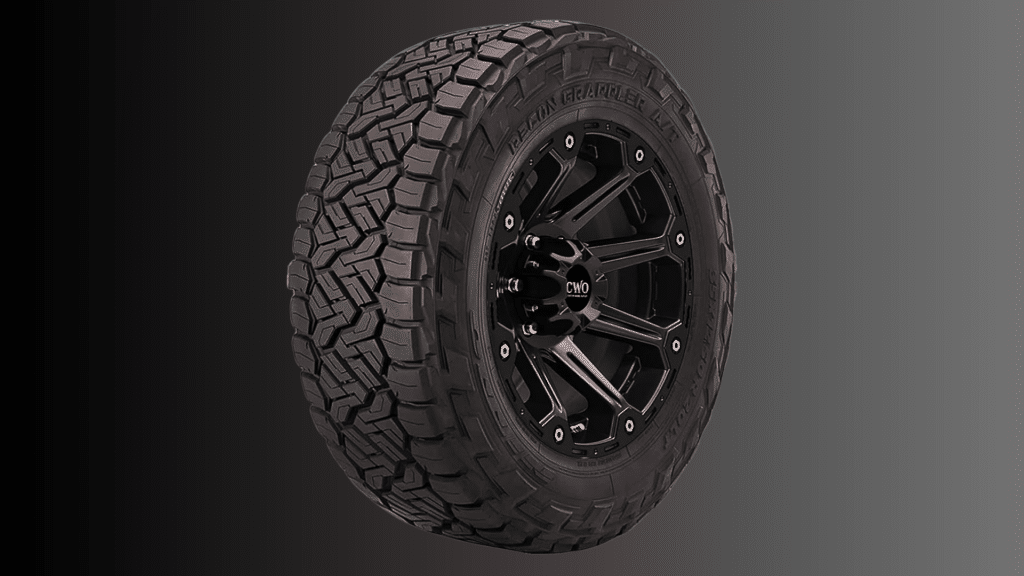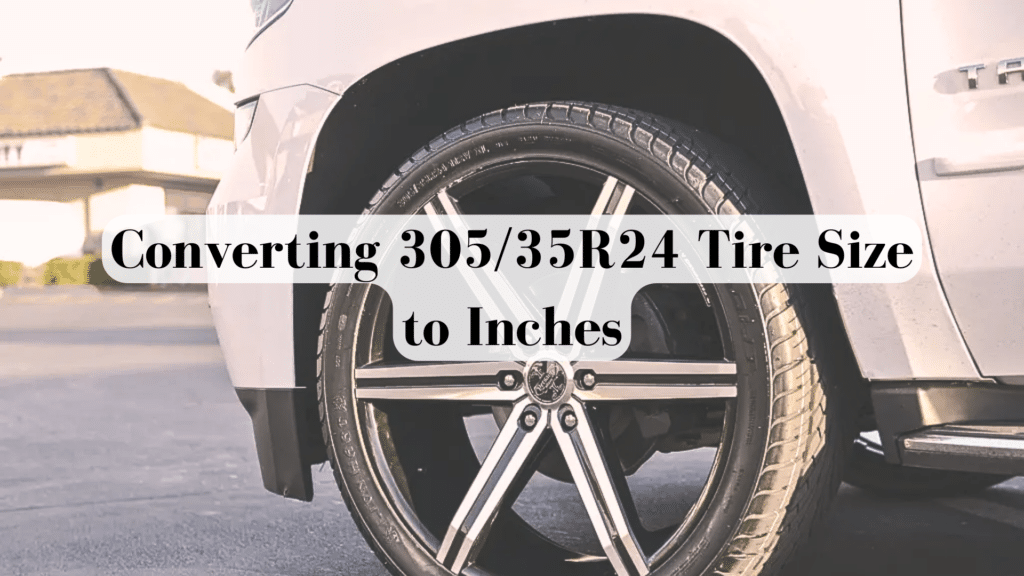Looking at “305/35R24” might make you scratch your head – but don’t worry.
I’ll break down this tire size into inches so you can understand exactly what these numbers mean for your vehicle.
Why this matters: The right tire size keeps you safe on the road and helps your car perform well.
Wrong sizes can affect your speedometer readings, handling, and fuel use.
Here’s what you’ll learn:
- How do you turn those tire size numbers into inches
- What each number in 305/35R24 means
- Simple steps to check if these tires will fit your car
My straightforward guide will show you how to make sense of these measurements without any complex math or technical terms.
What Does 305/35R24 Represent?

The first number, 305, shows the width of your tire in millimeters from one side to the other.
Think of it as measuring the width of your hand—it’s the distance across the tire when you look at it from the front.
The middle number, 35, tells us the tire’s height.
It’s a percentage—in this case, the tire’s height is 35% of its width.
This number helps us determine the height of the sidewall (the part between the rim and where the tire meets the road).
The last part, 24, is easy—it’s just your rim size in inches, which is the metal wheel at the center of your tire.
What about the R?
That “R” simply means these are Radial tires – the kind almost every car uses today.
Quick number recap:
- 305 = Width in millimeters
- 35 = Height as a percent of width
- 24 = Rim diameter in inches
Understanding these numbers helps you pick the right tires for your car.
Think of it like shoe size: You need the right fit for comfort and safety.
Converting 305/35R24 to Inches
Let me help you turn these metric numbers into inches. I’ll break it down into simple steps.
First, let’s convert the width
- Take 305 millimeters
- Divide by 25.4 (that’s how many millimeters are in an inch)
- 305 ÷ 25.4 = 12 inches wide
Now for the sidewall height
- Take the width (305mm)
- Multiply by 35% (0.35)
- 305 × 0.35 = 106.75mm sidewall height
- Convert to inches: 106.75 ÷ 25.4 = 4.2 inches tall
Total tire diameter calculation
- Start with rim size: 24 inches
- Add twice the sidewall height (4.2 × 2 = 8.4 inches)
- 24 + 8.4 = 32.4 inches total diameter
Here’s your tire in inches:
- Width: 12 inches
- Sidewall height: 4.2 inches
- Total diameter: 32.4 inches
Converting 305/35R24 to Millimeters
Since tire makers use the metric system, let me show you how these numbers work in millimeters.
This will help you match sizes exactly.
Here’s your width in millimeters
- The “305” is already in millimeters
- No math needed – it’s 305mm wide
Let’s find your sidewall height
- Take the width: 305mm
- Multiply by 35% (0.35)
- 305 × 0.35 = 106.75mm tall
Total tire size in millimeters
- Start with rim size: 24 inches × 25.4 = 609.6mm
- Add both sidewalls: 106.75mm × 2 = 213.5mm
- Total: 609.6 + 213.5 = 823.1mm diameter
Your complete tire measurements:
- Width: 305mm
- Sidewall: 106.75mm
- Total diameter: 823.1mm
Quick tip: Car makers worldwide use millimeters because they’re more precise than inches.
This helps you get an exact fit for your vehicle.
Mastering the Art of Reading 305/35R24 Tire Size
Let me teach you how to read tire sizes like a pro.
Once you know the code, you’ll better understand your tires.
Break it into three parts:
- First part (305) = Width
- Middle part (35) = Height ratio
- Last part (24) = Wheel size
Real-world examples
Look at your tire’s sidewall. You’ll see the numbers printed clearly in raised letters.
They might appear like this:
- P305/35R24 (P means passenger car)
- LT305/35R24 (LT means light truck)
Extra numbers you might see
- Load rating (like 89 or 91)
- Speed rating (T, H, or V)
- M+S (means mud and snow-ready)
Helpful memory trick: Think “Wide/High/Round.”
- Wide = First number
- High = Middle number
- Round = Last number
Quick check method
When you look at your tire, start from the widest part and work your way in:
- Measure the black rubber from side to side (305)
- Look at how tall it is (35)
- Check the metal rim size (24)
How Wide Is a 305/35R24 Tire?
- In millimeters: 305mm wide
- In inches: 12 inches wide
What this width means for you:
- More rubber meets the road
- Better grip in dry conditions
- Wider stance for your car
Some trade-offs to consider
- They might catch more water in the rain
- It could be harder to turn at low speeds
- Might use more fuel due to extra road contact
Size comparison
Think of 12 inches – that’s about:
- The length of a standard ruler
- The size of a dinner plate
- The width of a small laptop
Understanding the Sidewall Height of 305/35R24 Tires
- Height in millimeters: 106.75mm
- Height in inches: 4.2 inches
How I got these numbers
- Take the width (305mm)
- Multiply by 35% (the aspect ratio)
- Result: 106.75mm or 4.2 inches
What this height means for your ride:
Comfort factors:
- Less bounce over bumps
- Firmer road feel
- Quick steering response
Road performance:
- Better control during turns
- Fast reaction when you steer
- Less flex in the tire walls
Size comparison: 4.2 inches is about the height of:
- A coffee mug
- Two credit cards stacked
- A smartphone’s length
Things to think about
- Lower sidewalls mean you’ll feel bumps more
- Potholes might be harder on your wheels
- Your car will handle more precisely
What Rim Size Works Best for a 305/35R24 Tire?
Let me tell you exactly which rim size you need for your 305/35R24 tire.
The answer is simple: you must use a 24-inch rim.
Why 24-inch rims only?
- The “24” in your tire size is fixed
- These tires won’t fit smaller or larger rims
- They’re made specifically for 24-inch wheels
Rim width range
Your 305mm tire works best with rims that are:
- Minimum width: 10 inches
- Best width: 11 inches
- Maximum width: 12 inches
Vehicle compatibility: These tires typically fit:
- Large SUVs
- Custom trucks
- Luxury vehicles
Things to check before buying
- Your car’s load rating
- Wheel well clearance
- Brake caliper space
- Factory recommendations
Safety note: Using the wrong rim size can cause:
- Poor handling
- Uneven wear
- Safety risks
- Damage to your car
Decoding the Circumference of a 305/35R24 Tire
Let me help you determine how far your tire rolls in one complete turn.
This will affect your speed readings and gas mileage.
Here’s how to find your tire’s circumference:
- Get the total diameter (32.4 inches)
- Multiply by pi (3.14)
- Result: 101.7 inches per rotation
In other measurements
- Inches: 101.7
- Feet: 8.48
- Meters: 2.58
Effects on your driving
- Smaller circumference = speedometer reads too fast
- Larger circumference = speedometer reads too slow
- Different size = wrong mileage count
Quick math example: If your speedometer shows 60 mph with the wrong tire size, you might actually be going:
- 55 mph (with larger tires)
- 65 mph (with smaller tires)
Gas mileage note
Your car’s computer uses tire size to:
- Calculate fuel use
- Time gear shifts
- Control traction systems
Exploring Alternate Replacement Sizes for 305/35R24 Tires
Let me show you some other tire sizes that could work for your car.
These options keep your car at the right height and maintain proper speed readings.
Similar tire sizes you can use
- 295/35R24 (slightly narrower)
- 315/35R24 (slightly wider)
- 305/40R24 (taller sidewall)
- 305/30R24 (shorter sidewall)
Important measurements to match
- Total diameter: stay within 3% (32.4 inches)
- Width: stay within 10mm of 305
- Load rating: must be equal or higher
Before switching sizes, check:
- Your wheel well space
- Your car maker’s suggestions
- Local road conditions
- Your driving style
Size comparison effects
Wider tires (315):
- Better dry grip
- More road noise
- Higher fuel use
Narrower tires (295):
- Better wet handling
- Less road noise
- Better fuel savings
Conclusion
I appreciate you learning about the 305/35R24 tire size in inches.
Knowing how to convert these numbers is vital.
It helps you understand your vehicle’s needs, ensures safety, and smooths your ride.
Final tips for you:
- Measure your tire space.
- Match size and load ratings.
- Confirm with a trusted tire chart.
You can make good choices.
Always compare your data with a professional source.
If you feel unsure, contact an expert.
That way, you can achieve the perfect balance of safety and performance.
Thanks for reading my blog!
Take care on the road. Your tires matter.
Frequently Asked Questions
Are 305/35R24 Tires Too Wide For A Smaller Pickup?
They might be if there’s not enough wheel clearance.
Check your owner’s manual or talk to a tire expert first.
Will Changing Tire Size Affect My Gas Mileage?
Yes, bigger tires can affect fuel usage.
Heavier or wider tires often reduce mileage.
Pick a size that suits your driving needs and budget.
Do I Need Special Rims For 305/35R24?
You need rims that match the tire width and offset.
Poor fit can lead to clearance problems and uneven wear.
How Often Should I Rotate 305/35R24 Tires?
Rotate them every 5,000 to 8,000 miles.
Regular rotation keeps wear even and extends tire life.
Follow your vehicle’s schedule.
Can I Use 305/35R24 Tires In Winter Conditions?
It depends on the tread and rubber mix.
Many 305/35R24 tires are built for summer or all-season use.
Check the label or consult an expert.


